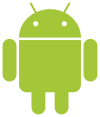Android (operating system)
From Wikipedia, the free encyclopedia
Not to be confused with Android (robot).
 The green Android logo, designed by graphic designer Irina Blok.[1][2][3] | |
 Android 4.2 "Jelly Bean" on the Nexus 4 | |
| Company / developer | Google Open Handset Alliance Android Open Source Project |
|---|---|
| Programmed in | C, C++, Java[4] |
| OS family | Unix-like |
| Working state | Current |
| Source model | Open source[5] |
| Initial release | September 23, 2008[6] |
| Latest stable release | 4.2.2 Jelly Bean / February 11, 2013[7] |
| Marketing target | Smartphones Tablet computers |
| Available language(s) | Multi-lingual |
| Package manager | Google Play, APK |
| Supported platforms | ARM, MIPS,[8] x86,[9]I.MX[10] |
| Kernel type | Monolithic (modified Linux kernel) |
| Default user interface | Graphical (Multi-touch) |
| License | Apache License 2.0 Linux kernel patches under GNU GPL v2[11] |
| Official website | www.android.com |
Android is a Linux-based operating system[12] designed primarily for touchscreen mobile devices such as smartphones and tablet computers. Initially developed by Android, Inc., which Google backed financially and later bought in 2005,[13] Android was unveiled in 2007 along with the founding of the Open Handset Alliance: a consortium of hardware, software, and telecommunication companies devoted to advancing open standards for mobile devices.[14] The first Android-powered phone was sold in October 2008.[15]
Android is open source and Google releases the code under the Apache License.[12] This open source code and permissive licensing allows the software to be freely modified and distributed by device manufacturers, wireless carriers and enthusiast developers. Additionally, Android has a large community of developers writing applications ("apps") that extend the functionality of devices, written primarily in a customized version of the Javaprogramming language.[16] In October 2012, there were approximately 700,000 apps available for Android, and the estimated number of applications downloaded from Google Play, Android's primary app store, was 25 billion.[17][18]
These factors have contributed towards making Android the world's most widely used smartphone platform,[19] overtaking Symbian in the fourth quarter of 2010,[20] and the software of choice for technology companies who require a low-cost, customizable, lightweight operating system for high tech devices without developing one from scratch.[21]As a result, despite being primarily designed for phones and tablets, it has seen additional applications on televisions, games consoles, digital cameras and other electronics. Android's open nature has further encouraged a large community of developers and enthusiasts to use the open source code as a foundation for community-driven projects, which add new features for advanced users[22] or bring Android to devices which were officially released running other operating systems.
Android had a worldwide smartphone market share of 75% during the third quarter of 2012,[23] with 750 million devices activated in total and 1.5 million activations per day.[24]The operating system's success has made it a target for patent litigation as part of the so-called "smartphone wars" between technology companies.[25][26] As of May 2013, a total of 900 million Android devices have been activated and 48 billion apps have been installed from the Google Play store

No comments:
Post a Comment